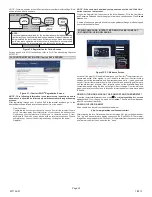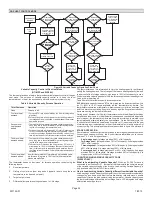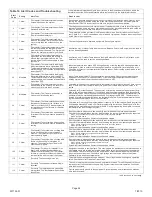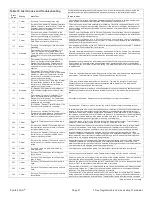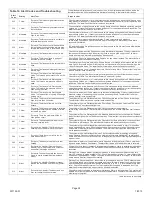
iComfort Wi-Fi
®
7-Day Programmable Communicating Thermostat
Page 15
DE-HUMIDIFICATION SETTINGS — FEATURE SCREEN
1. From the
Main Screen
, press the
right arrow
icon to go the the
Features
screen.
2. From the
Features
screen, select
system systems
.
3. Touch the
ClimateIQ
setting button. Available options when selected are
selection for DRY, MODERATE and HUMID.
4. Selecting HUMID bring on the
set-to
button. When you touch the
set-to
button, the arrows appear, allowing you to change to the desired de-humidifier
percentage setting
SYSTEM SETTINGS
heating
mode
COMFORT
humidifier
is ON
ClimateIQ
setting
MOD
humidifier
display
is ON
Appears only when
heat pump is
present
humidification
settings
De-humidification settings
(default is DRY)
(default is ON)
(default is ON)
Select the humidity
level that matches
your environment
9:39 am Aug 15, 2012
?
Wi-Fi
35
%
set to
40
%
set to
Figure 17. Humidifier Controls (Communicating Outdoor Unit)
HEATING MODE (XP25 ONLY) — CLIMATE IQ™
This technology optimizes De-humidification settings for specific climates to
improve home comfort during cooling or heating operations.
Two climate settings are available:
Comfort
The system reduces indoor airflow, increasing supply air
temperature.
Normal
Standard system operation.
COOLING MODE — CLIMATE IQ™
Three climate settings are available:
Dry
The system supplies higher indoor airflow at all compressor capacities,
increasing efficiency by operating at a higher sensible to total ratio.
Moderate
The system supplies indoor airflow that balances efficiency and
comfort.
Humid
The system supplies lower indoor airflow at all compressor
capacities, improving humidity removal by operating at a lower sensible to
total ratio.
How De-humidification Mode Works
DRY, MODERATE AND HUMID
—These modes allow user control of
relative humidity between 40% and 60% RH. These conditions must be
met for either mode to operate:
de-humidification mode has been enabled, and
the unit is in COOL mode, and
-de-humidification demand exists (0V present at H), and
MODERATE
mode also requires presence of cooling demand [Y for HP
heat, or W for gas heat (W may be energized with G de-energized)].
Humiditrol
®
or Auxiliary Dehumidifier
mode requires:
NOTE - Systems using icomfort
t
and a de-humidifier - “Dehum” jump
er on furnace/air handler control does not need to be cut when using
with a iComfort Wi-Fi
®
thermostat.
Wi-Fi is operational or outdoor sensor is installed and set up
de-humidification has been enabled on installer settings, and
the unit is in COOL mode, (or if in AUTO, at least one thermostat
cooling call made prior to the De-humidification demand), and
a de-humidification demand exists (RH above set point), and
outdoor temp. below 95°F; indoor temp. above 65°F, and
for
HUMIDITROL
, adjust Humiditrol
®
comfort parameters as fol
lows:
MAX
adj. - Indoor temp > 2°F above heating set point
MID
adj. - Indoor temp >
MIN
adj. - Indoor temp > 2°F below cooling set point
HEAT se COOL setpoint
2
2
AUXILIARY DEHUMIDIFIER — STAND-ALONE DEHUMIDIFIER
When this option is selected, De-humidification will be allowed under the following
conditions, provided
there is NO call for humidification
:
In the absence of heating or cooling calls, or
Simultaneous with blower only calls.
If the blower is required to operate while the auxiliary dehumidifier is running, a
separate wire must be installed from the auxiliary dehumidifier to the indoor unit's G
thermostat input that will energize G when the auxiliary dehumidifier is running (see
wiring diagram on page 37).
Auxiliary De-humidification is controlled by the thermostat De-humidification
demand.
NOTE - Refer to HCWH Dehumidifier Installation Instructions for installation
recommendations.
HOW DE-HUMIDIFICATION MODE WORK — NO EXTERNAL
DE-HUMIDIFICATION DEVICE
NOTE -
OFF, MEDIUM
and
HIGH
De-humidification modes are also a function of the
HVAC system with NO external De-humidification devices installed.
In
OFF
mode, De-humidification if off.
In
MEDIUM
mode, De-humidification occurs if these conditions are met and signals are
present at specific terminals:
De-humidification has been enabled on installer settings, and
the unit is in COOL mode, and
De-humidification demand exists (RH above set point), and
cooling demand exists (Y1 energized).
In
HIGH
mode, De-humidification occurs if all BASIC conditions are true, except cooling
demand may or may not be present. Also note that:
Maximum overcool from cooling set point is 2ºF.
Deadband
temperature is limited to a minimum of 5ºF (instead of 3ºF in
DRY
or
MODERATE
modes) because of 2ºF overcooling.
G71MPP OR SLP98 FURNACE SETTING ADJUSTMENT
If your iComfort Wi-Fi
®
thermostat is being used with a G71MPP or SLP98 furnace
and is set to variable-capacity mode of operation (the icomfort
default with these
units), the thermostat's settings for stage timers are ignored (even if shown enabled
in the thermostat). The stage timer will be used on the cooling side for other cooling
units except the XC/XP25 where they are not used. The furnace software sets and
controls the firing rates. The only other controlling factor is the stage temperature
differentials. In Load-Tracking Variable Capacity (default for these furnaces), both
stage timers and temperature differentials are ignored.
ZONING CONTROL SETTINGS
NOTE - Skip if no zoning control device is installed.
A. Heat/Cool Changeover
The following is an example of how the system operates during a heating / cooling
changeover.
When the system is satisfying a call from zone 1 for heating and receives a call for
cooling from zone 2, the following will occur:
Then system will continue to fulfill the demand from zone 1 until satisfied, or
a maximum time of 20 minutes has occurred.
If after 20 minutes the system is still operating based on satisfying the heating
demand from zone 1, the system will terminate that demand.
The system will then shut system down for five (5) minutes. This will allow for
system temperatures and operating pressures to stabilize.
After a five 5 minute delay the system will begin operations to satisfied the
cooling demand from zone 2.
The system will continue to operate in this matter each time it receives a zone call
that is opposite of the current mode of operation (heating or cooling).
B. Damper Operation
Cooling Operation Conventional Heat/Cool and Heat Pump Systems
When a in-zone thermostat makes a demand for cooling, the zone damper opens
and the cooling equipment begins operating.
Cooling demand is terminated when:
1. All zone demands for cooling are terminated.
2. The demand has exceeded the heat/cool changeover
time limit (20minutes)
while a heat demand exists.




















